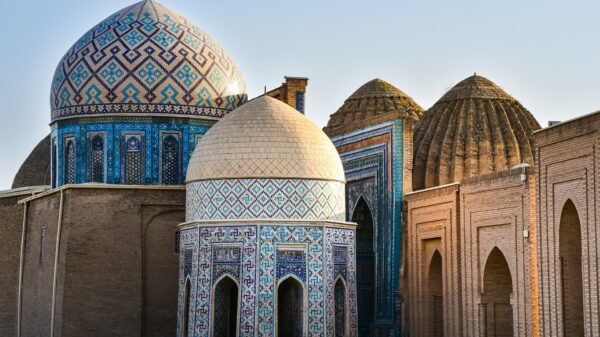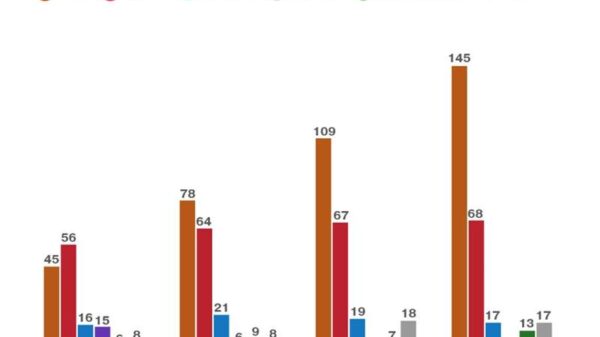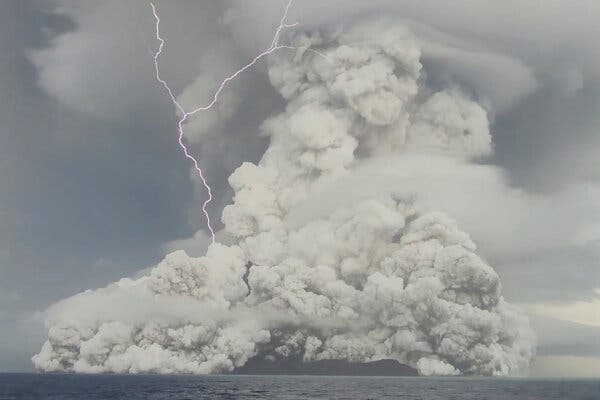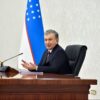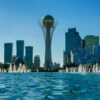The explosion probably won’t cool the planet as some previous eruptions have done, but its effects could be felt around the world in other ways.
We’re also covering Arctic glaciers, a new study on extreme heat and child health, and an inventor who wants to demystify smells.
When the Hunga volcano in the Pacific island nation of Tonga erupted with a huge explosion on Saturday, climate scientists took notice. Eruptions emit sulfur dioxide gas, and if enough of it is shot high enough into the atmosphere, it can have a cooling effect on the Earth.
But eruptions that are big enough to do that are rare. The last one was at Mount Pinatubo in the Philippines, which pumped about 20 million tons of the gas into the air when it erupted in 1991. That led to global cooling of about 1 degree Fahrenheit, or half a degree Celsius, for nearly two years.
If the eruption of the Hunga volcano was anything like Pinatubo, climate scientists would have a lot to study about natural influences on climate. NASA has even developed a rapid-response program to quickly deploy balloon-laden instruments to gather data after such a large eruption.
From satellite pictures of the Hunga eruption, it seemed like it might be another Pinatubo-like event. But looks turned out to be deceiving. Satellite sensors measured a relatively small amount of sulfur dioxide, about 2 percent of Pinatubo’s output. Not enough to provide a temporary respite from the inexorable march of global warming.
From a climate standpoint, Hunga was pretty ordinary. But it was extraordinary in many other ways, as I wrote this week in an article about the eruption. The explosion created a pressure wave that was the largest that some scientists had ever seen, and tsunamis were generated not just at the source of the blast but all around the world. Hunga may have left climate scientists with little to talk about, but other researchers will be discussing, and studying, this eruption for a long time.
Quotable: “Not that we weren’t aware of volcanic explosions and tsunamis,” said Lori Dengler, a geophysicist. “But to witness it with the modern array of instruments we have is truly unprecedented.”
Old photos that could open a window on the future
A trove of more than 5,500 black-and-white photos from 1930s mapping expeditions is helping scientists peer into the future of the Svalbard Islands, an Arctic archipelago where rapid warming is melting the glaciers at an alarming rate.
By using the aerial pictures to construct three-dimensional digital models of the glaciers’ every nook and crevasse from eight decades ago, researchers can make better predictions about how quickly the ice will disappear as a result of climate change in the 21st century.
The methods used to create the large-scale computer reconstructions, which I wrote about this week, could be used with archival images of glaciers in other parts of the world to unlock insights there, too.
Numbers: Over the past three decades, Svalbard has warmed twice as quickly as the rest of the Arctic region and seven times the global average.
How extreme heat harms children
The first nationwide study on rising temperatures and younger Americans has found that hotter days are associated with more visits to emergency rooms.
That might not seem remarkable when it comes to conditions like heat stroke, but a number of the findings surprised researchers. For instance, the increased risk for children suffering from blood and immune-system diseases during periods of higher heat are not easily explained and have not been seen in studies of adults.
The research adds to a growing body of evidence of the dangers that heat poses to vulnerable populations, including children and adolescents. You can get the details in my article this week.
Quotable: “We’ve run into trouble previously assuming that children are little adults,” said Dr. Aaron Bernstein, a pediatrician at the Boston Children’s Hospital.
Understand the Latest News on Climate Change
A warming trend. European scientists announced that 2021 was Earth’s fifth hottest year on record, with the seven hottest years ever recorded being the past seven. A Times analysis of temperatures in the United States showed how 2021 outpaced previous years in breaking all-time heat records.
Why it matters: With climate change, heat waves and rising temperatures are becoming more frequent.
Amazon’s craving for electric vans
The company has big plans to turn its delivery fleet green. But very few of the vehicles are made right now.
Also important this week:
-
Last year’s average temperature globally was either fifth or sixth highest on record, depending on who’s measuring.
-
The Biden Administration has announced a plan to spend billions to prevent wildfires.
-
The president of Mexico is investing heavily in the state-owned oil company. Critics say he is reneging on the country’s climate commitments.
-
Exxon said it had the “ambition” to reach net-zero greenhouse gas emissions by 2050, but the target does not account for the climate impact of its customers and suppliers.
And finally:
Just trust your nose
On the most basic level, smell is nothing more than the result of chemical concentrations in the air. And yet it seems to wield remarkable power: It can affect our health, trigger old memories, bring joy or wreak havoc. Often, it can seem impossible to describe or convey to others.
That’s why, for the past 50 years, Chuck McGinley, a chemical engineer and odor expert, has been determined to give everyone the confidence in their nose that they already have in their eyes and ears.
Over the course of several days in August, Mr. McGinley and his son, Mike, showed me around their lab. It was a veritable wonderland of smells: A repurposed bank vault stored the stinkiest compounds like skunk and indole (also known as “the smell of death”), samples of cat pee and poop lined a shelf in the office freezer, and towels infused with Mike’s proprietary “moldy smell” recipe were stacked near a laundry machine.
But the tools that Mr. McGinley has invented and fine-tuned may be his greatest contribution to our understanding of smells. Instruments like his Nasal Ranger, a Dr. Seussian device that can help people quantify odor, and his odor wheel, which provides users with a vocabulary to more clearly convey what they are sensing. With this, McGinley has tried to give people a rich new language for what they smell and has challenged a longstanding myth that smell cannot be measured.
You can read or listen to my article here. And, there are more photos and odor facts here.
If you’re not getting Climate Fwd: in your inbox, you can sign up here
We’d love your feedback on the newsletter. We read every message, and reply to many! Please email thoughts and suggestions to climateteam@nytimes.com.









